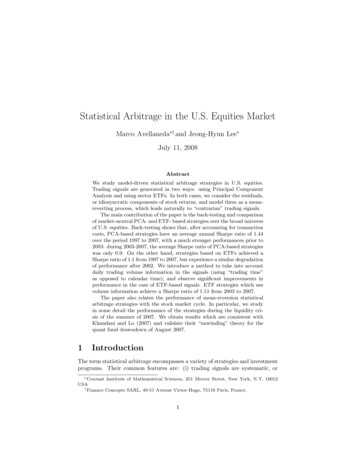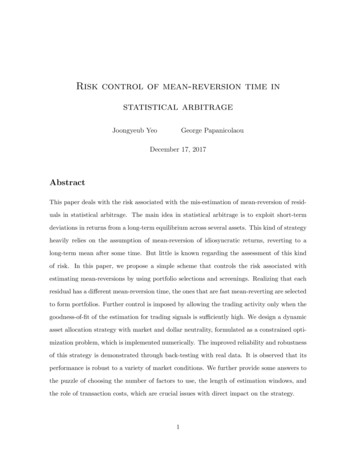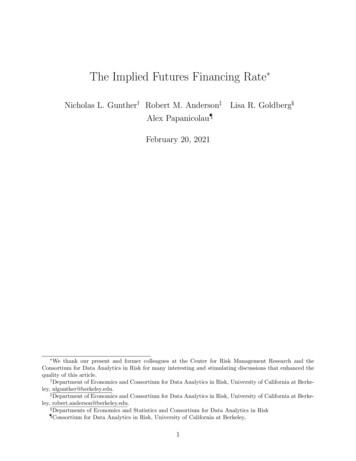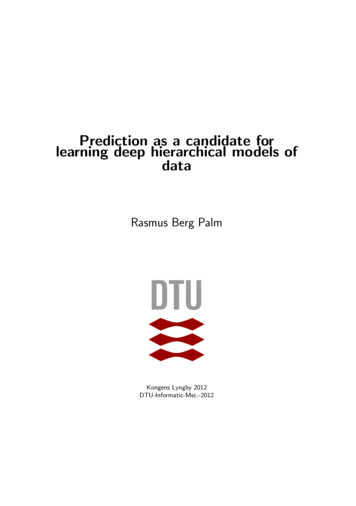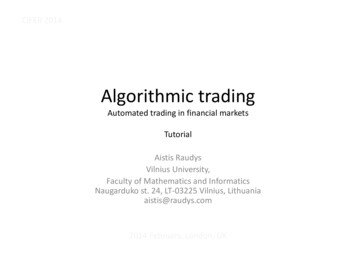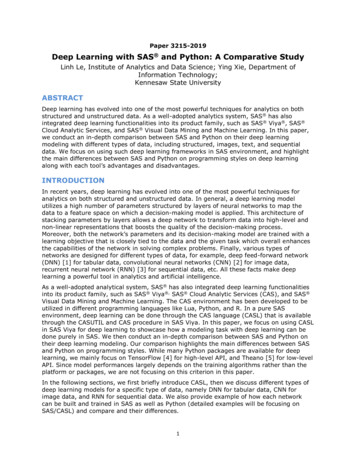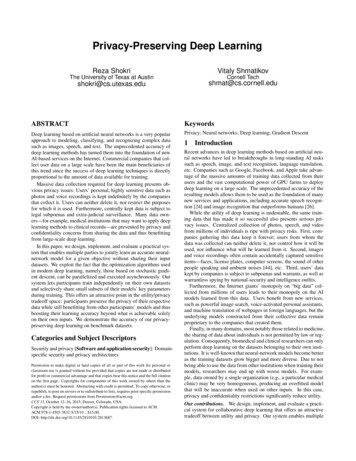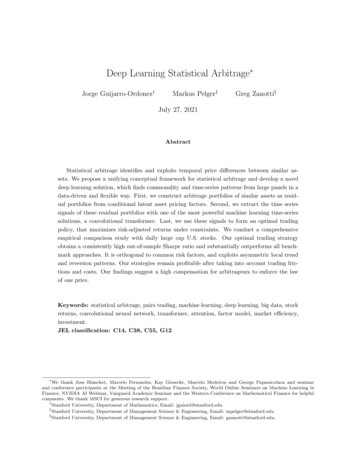
Transcription
Deep Learning Statistical Arbitrage Jorge Guijarro-Ordonez†Markus Pelger‡Greg Zanotti§July 27, 2021AbstractStatistical arbitrage identifies and exploits temporal price differences between similar assets. We propose a unifying conceptual framework for statistical arbitrage and develop a noveldeep learning solution, which finds commonality and time-series patterns from large panels in adata-driven and flexible way. First, we construct arbitrage portfolios of similar assets as residual portfolios from conditional latent asset pricing factors. Second, we extract the time seriessignals of these residual portfolios with one of the most powerful machine learning time-seriessolutions, a convolutional transformer. Last, we use these signals to form an optimal tradingpolicy, that maximizes risk-adjusted returns under constraints. We conduct a comprehensiveempirical comparison study with daily large cap U.S. stocks. Our optimal trading strategyobtains a consistently high out-of-sample Sharpe ratio and substantially outperforms all benchmark approaches. It is orthogonal to common risk factors, and exploits asymmetric local trendand reversion patterns. Our strategies remain profitable after taking into account trading frictions and costs. Our findings suggest a high compensation for arbitrageurs to enforce the lawof one price.Keywords: statistical arbitrage, pairs trading, machine learning, deep learning, big data, stockreturns, convolutional neural network, transformer, attention, factor model, market efficiency,investment.JEL classification: C14, C38, C55, G12 We thank Jose Blanchet, Marcelo Fernandes, Kay Giesecke, Marcelo Medeiros and George Papanicolaou and seminarand conference participants at the Meeting of the Brazilian Finance Society, World Online Seminars on Machine Learning inFinance, NVIDIA AI Webinar, Vanguard Academic Seminar and the Western Conference on Mathematical Finance for helpfulcomments. We thank MSCI for generous research support.†Stanford University, Department of Mathematics, Email: jguiord@stanford.edu.‡Stanford University, Department of Management Science & Engineering, Email: mpelger@stanford.edu.§Stanford University, Department of Management Science & Engineering, Email: gzanotti@stanford.edu.
I.IntroductionStatistical arbitrage is one of the pillars of quantitative trading, and has long been used byhedge funds and investment banks. The term statistical arbitrage encompasses a wide variety ofinvestment strategies, which identify and exploit temporal price differences between similar assetsusing statistical methods. Its simplest form is known as “pairs trading”. Two stocks are selectedthat are “similar”, usually based on historical co-movement in their price time-series. When thespread between their prices widens, the arbitrageur sells the winner and buys the loser. If theirprices move back together, the arbitrageur will profit. While Wall Street has developed a plethoraof proprietary tools for sophisticated arbitrage trading, there is still a lack of understanding ofhow much arbitrage opportunity is actually left in financial markets. In this paper we answer thetwo key questions around statistical arbitrage: What are the important elements of a successfularbitrage strategy and how much realistic arbitrage is in financial markets?Every statistical arbitrage strategy needs to solve the following three fundamental problems:Given a large universe of assets, what are long-short portfolios of similar assets? Given theseportfolios, what are time series signals that indicate the presence of temporary price deviations?Last, but not least, given these signals, how should an arbitrageur trade them to optimize a tradingobjective while taking into account possible constraints and market frictions? Each of these threequestions poses substantial challenges, that prior work has only partly addressed. First, it is ahard problem to find long-short portfolios for all stocks as it is a priori unknown what constitutes“similarity”. This problem requires considering all the big data available for a large number ofassets and times, including not just conventional return data but also exogenous information likeasset characteristics. Second, extracting the right signals requires detecting flexibly all the relevantpatterns in the noisy, complex, low-sample-size time series of the portfolio prices. Last but notleast, optimal trading rules on a multitude of signals and assets are complicated and depend onthe trading objective. All of these challenges fundamentally require flexible estimation tools thatcan deal with many variables. It is a natural idea to use machine learning techniques like deepneural networks to deal with the high dimensionality and complex functional dependencies of theproblem. However, our problem is different from the usual prediction task, where machine learningtools excel. We show how to optimally design a machine learning solution to our problem thatleverages the economic structure and objective.In this paper, we propose a unifying conceptual framework that generalizes common approachesto statistical arbitrage. Statistical arbitrage can be decomposed into three fundamental elements:(1) arbitrage portfolio generation, (2) arbitrage signal extraction and (3) the arbitrage allocationdecision given the signal. By decomposing different methods into their arbitrage portfolio, signaland allocation element, we can compare different methods and study which components are the mostrelevant for successful trading. For each step we develop a novel machine learning implementation,which we compare with conventional methods. As a result, we construct a new deep learningstatistical arbitrage approach. Our new approach constructs arbitrage portfolios with a conditionallatent factor model, extracts the signals with the currently most successful machine learning time1
series method and maps them into a trading allocation with a flexible neural network. Thesecomponents are integrated and optimized over a global economic objective, which maximizes therisk-adjusted return under constraints. Empirically, our general model outperforms out-of-samplethe leading benchmark approaches and provides a clear insight into the structure of statisticalarbitrage.To construct arbitrage portfolios, we introduce the economically motivated asset pricing perspective to create them as residuals relative to asset pricing models. This perspective allows us totake advantage of the recent developments in asset pricing and to also include a large set of firmcharacteristics in the construction of the arbitrage portfolios. We use fundamental risk factors andconditional and unconditional statistical factors for our asset pricing models. Similarity betweenassets is captured by similar exposure to those factors. Arbitrage Pricing Theory implies that, withan appropriate model, the corresponding factor portfolios represent the “fair price” of each of theassets. Therefore, the residual portfolios relative to the asset pricing factors capture the temporary deviations from the fair price of each of the assets and should only temporally deviate fromtheir long-term mean. Importantly, the residuals are tradeable portfolios, which are only weaklycross-sectionally correlated, and close to orthogonal to firm characteristics and systematic factors.These properties allow us to extract a stationary time-series model for the signal.To detect time series patterns and signals in the residual portfolios, we introduce a filter perspective and estimate them with a flexible data-driven filter based on convolutional networks combinedwith transformers. In this way, we do not prescribe a potentially misspecified function to extract thetime series structure, for example, by estimating the parameters of a given parametric time-seriesmodel, or the coefficients of a decomposition into given basis functions, as in conventional methods.Instead, we directly learn in a data-driven way what the optimal pattern extraction function is forour trading objective. The convolutional transformer is the ideal method for this purpose. Convolutional neural networks are the state-of-the-art AI method for pattern recognition, in particularin computer vision. In our case they identify the local patterns in the data and may be thoughtas a nonlinear and learnable generalization of conventional kernel-based data filters. Transformernetworks are the most successful AI model for time series in natural language processing. In ourmodel, they combine the local patterns to global time-series patterns. Their combination results ina data-driven flexible time-series filter that can essentially extract any complex time-series signal,while providing an interpretable model.To find the optimal trading allocation, we propose neural networks to map the arbitrage signalsinto a complex trading allocation. This generalizes conventional parametric rules, for example fixedrules based on thresholds, which are only valid under strong model assumptions and a small signaldimension. Importantly, these components are integrated and optimized over a global economicobjective, which maximizes the risk-adjusted return under constraints. This allows our modelto learn the optimal signals and allocation for the actual trading objective, which is differentfrom a prediction objective. The trading objective can maximize the Sharpe ratio or expectedreturn subject to a risk penalty, while taking into account constraints important to real investment2
managers, such as restricting turnover, leverage, or proportion of short trades.Our comprehensive empirical out-of-sample analysis is based on the daily returns of roughly the550 largest and most liquid stocks in the U.S. from 1998 to 2016. We estimate the out-of-sampleresiduals on a rolling window relative to the empirically most important factor models. Theseare observed fundamental factors, for example the Fama-French 5 factors and price trend factors,locally estimated latent factors based on principal component analysis (PCA) or locally estimatedconditional latent factors that include the information in 46 firm-specific characteristics and arebased on the Instrumented PCA (IPCA) of Kelly et al. (2019). We extract the trading signal withone of the most successful parametric models, based on the mean-reverting Ornstein-Uhlenbeckprocess, a frequency decomposition of the time-series with a Fourier transformation and our novelconvolutional network with transformer. Finally, we compare the trading allocations based onparametric or nonparametric rules estimated with different risk-adjusted trading objectives.Our empirical main findings are five-fold. First, our deep learning statistical arbitrage modelsubstantially outperforms all benchmark approaches out-of-sample. In fact, our model can achievean impressive annual Sharpe ratio larger than four. While respecting short-selling constraints wecan obtain annual out-of-sample mean returns of 20%. This performance is four times better thanone of the best parametric arbitrage models, and twice as good as an alternative deep learningmodel without the convolutional transformer filter. These results are particularly impressive as weonly trade the largest and most liquid stocks. Hence, our model establishes a new standard forarbitrage trading.Second, the performance of our deep learning model suggests that there is a substantial amountof short-term arbitrage in financial markets. The profitability of our strategies is orthogonal tomarket movements and conventional risk factors including momentum and reversal factors anddoes not constitute a risk-premium. Our strategy performs consistently well over the full timehorizon. The model is extremely robust to the choice of tuning parameters, and the period whenit is estimated. Importantly, our arbitrage strategy remains profitable in the presence of realistictransaction and holdings costs. Assessing the amount of arbitrage in financial markets with unconditional pricing errors relative to factor models or with parametric statistical arbitrage models,severely underestimates this quantity.Third, the trading signal extraction is the most challenging and separating element among different arbitrage models. Surprisingly, the choice of asset pricing factors has only a minor effecton the overall performance. Residuals relative to the five Fama-French factors and five locallyestimated principal component factors perform very well with out-of-sample Sharpe ratios above3.2 for our deep learning model. Five conditional IPCA factors increase the out-of-sample Sharperatio to 4.2, which suggests that asset characteristics provide additional useful information. Increasing the number of risk factors beyond five has only a marginal effect. Similarly, the otherbenchmark models are robust to the choice of factor model as long as it contains sufficiently manyfactors. The distinguishing element is the time-series model to extract the arbitrage signal. Theconvolutional transformer doubles the performance relative to an identical deep learning model3
with a pre-specified frequency filter. Importantly, we highlight that time-series modeling requires atime-series machine learning approach, which takes temporal dependency into account. An off-theshelf nonparametric machine learning method like conventional neural networks, that estimates anarbitrage allocation directly from residuals, performs substantially worse.Fourth, successful arbitrage trading is based on local asymmetric trend and reversion patterns.Our convolutional transformer framework provides an interpretable representation of the underlyingpatterns, based on local basic patterns and global “dependency factors”. The building blocks ofarbitrage trading are smooth trend and reversion patterns. The arbitrage trading is short-termand the last 30 trading days seem to capture the relevant information. Interestingly, the directionof policies is asymmetric. The model reacts quickly on downturn movements, but more cautiouslyon uptrends. More specifically, the “dependency factors” which are the most active in downturnmovements focus only on the most recent 10 days, while those for upward movements focus on thefirst 20 days in a 30-day window.Fifth, time-series-based trading patterns should be extracted from residuals and not directlyfrom returns. For an appropriate factor model, the residuals are only weakly correlated and closeto stationary in both, the time and cross-sectional dimension. Hence, it is meaningful to extracta uniform trading pattern, that is based only on the past time-series information, from the residuals. In contrast stock returns are dominated by a few factors, which severely limits the actualindependent time-series information, and are strongly heterogenous due to their variation in firmcharacteristics. While the level of stock returns is extremely hard to predict, even with flexiblemachine learning methods, residuals capture relative movements and remove the level component.These properties make residuals analyzable from a purely time-series based perspective and, unlikethe existing literature, they allow us to incorporate alternative data into the portfolio constructionprocess. This also highlights a fundamental difference with most of the existing financial machinelearning literature: We do not use characteristics to get features for prediction, but rather togenerate new data orthogonal to these features.Related LiteratureOur paper builds on the classical statistical arbitrage literature, in which the three main problems of portfolio generation, pattern extraction, and allocation decision have traditionally beenconsidered independently. Classical statistical methods of generating arbitrage portfolios havemostly focused on obtaining multiple pairs or small portfolios of assets, using techniques like thedistance method of Gatev et al. (2006), the cointegration approach of Vidyamurthy (2004), or copulas as in Rad et al. (2016). In contrast, more general methods that exploit large panels of stockreturns include the use of PCA factor models, as in Avellaneda and Lee (2010) and its extensionin Yeo and Papanicolaou (2017), and the maximization of mean-reversion and sparsity statistics asin d’Aspremont (2011). We include the model of Yeo and Papanicolaou (2017) as the parametricbenchmark model in our study as it has one of the best empirical performances among the class ofparametric models. Our paper paper contributes to this literature by introducing a general asset4
pricing perspective to obtain the arbitrage portfolios as residuals. This allows us to take advantageof conditional asset pricing models, that include time-varying firm characteristics in addition to thereturn time-series, and provides a more disciplined, economically motivated approach. The signalextraction step for these models assumes parametric time series models for the arbitrage portfolios,whereas the allocations are often decided from the estimated parameters by using stochastic control methods or given threshold rules and one-period optimizations. Some representative papersof the first approach include Jurek and Yang (2007), Mudchanatongsuk et al. (2008), Cartea andJaimungal (2016), Lintilhac and Tourin (2016) and Leung and Li (2015), whereas the second one isillustrated by Elliott et al. (2005) and Yeo and Papanicolaou (2017). Both approaches are specialcases of our more general framework. Mulvey et al. (2020) and Kim and Kim (2019) are examples of including machine learning elements within the parametric statistical arbitrage framework,by either solving a stochastic control problem with neural networks or estimating a time-varyingthreshold rule with reinforcement learning.Our paper is complementary to the emerging literature that uses machine learning methods forasset pricing. While the asset pricing literature aims to explain the risk premia of assets, our focus ison the residual component which is not explained by the asset pricing models. Chen et al. (2019),Bryzgalova et al. (2019) and Kozak et al. (2020) estimate the stochastic discount factor (SDF),which explains the risk premia of assets, with deep neural networks, decision trees or elastic netregularization. These papers employ advanced statistical methods to solve a conditional method ofmoment problem in the presence of many variables. The workhorse models in equity asset pricingare based on linear factor models exemplified by Fama and French (1993, 2015). Recently, newmethods have been developed to extract statistical asset pricing factors from large panels withvarious versions of principal component analysis (PCA). The Risk-Premium PCA in Lettau andPelger (2020a,b) includes a pricing error penalty to detect weak factors that explain the crosssection of returns. The high-frequency PCA in Pelger (2020) uses high-frequency data to estimatelocal time-varying latent risk factors and the Instrumented PCA (IPCA) of Kelly et al. (2019)estimates conditional latent factors by allowing the loadings to be functions of time-varying assetcharacteristics. Gu et al. (2021) generalize IPCA to allow the loadings to be nonlinear functions ofcharacteristics.Our paper is related to the growing literature on return prediction with machine learning methods, which has shown the benefits of regularized flexible methods. In their pioneering work Guet al. (2020) conduct a comparison of machine learning methods for predicting the panel of individual U.S. stock returns based on the asset-specific characteristics and economic conditions inthe previous period. In a similar spirit, Bianchi et al. (2019) predict bond returns and Freybergeret al. (2020) use different methods for predicting stock returns. This literature is fundamentallyestimating the risk premia of assets, while our focus is on understanding and exploiting the temporal deviations thereof. This different goal is reflected in the different methods that are needed.These return predictions estimate a nonparametric model between current returns and large set ofcovariates from the last period, but do not estimate a time-series model. In contrast, the important5
challenge that we solve is to extract a complex time-series pattern. A related stream of this literature forecasts returns using past returns, generally followed by some long-short investment policybased on the prediction. For example, Krauss et al. (2017) use various machine learning methodsfor this type of prediction.1 However, they use general nonparametric function estimates, whichare not specifically designed for time-series data. Lim and Zohren (2020) show that it is importantfor machine learning solutions to explicitly account for temporal dependence when they are appliedto time-series data. Forecasting returns and building a long-short portfolio based on the predictionis different from statistical arbitrage trading as it combines a risk premium and potential arbitragecomponent. It is not based on temporary price differences and also in general not orthogonal tocommon risk factors and market movements. In this paper we highlight the challenge of inferringcomplex time-series information and argue that using returns directly as an input to a time-seriesmachine learning method, is suboptimal as returns are dominated by a few factor time-series andheterogeneous due to cross-sectionally and time-varying characteristics. In contrast, appropriateresiduals are locally stationary and hence allow the extraction of a complex time-series pattern.Naturally, our work overlaps with the literature on using machine learning tools for investment.The SDF estimated by asset pricing models, like in Chen et al. (2019) and Bryzgalova et al. (2019),directly maps into a conditionally mean-variance efficient portfolio and hence an attractive investment opportunity. However, by construction this investment portfolio is not orthogonal but fullyexposed to systematic risk, which is exactly the opposite for an arbitrage portfolio. Predictionapproaches also imply investment strategies, typically long-short portfolios based on the prediction signal. However, estimating a signal with a prediction objective, is not necessarily providingan optimal signal for investment. Bryzgalova et al. (2019) and Chen et al. (2019) illustrate thatmachine learning models that use a trading objective can result in a substantially more profitableinvestment than models that estimate a signal with a prediction objective, while using the sameinformation as input and having the same flexibility. This is also confirmed in Cong et al. (2020),who use an investment objective and reinforcement learning to construct machine learning investment portfolios. Our paper contributes to this literature by estimating investment strategies, thatare orthogonal to systematic risk and are based on a trading objective with constraints.Finally, our approach is also informed by the recent deep learning for time series literature. Thetransformer method was first introduced in the groundbreaking paper by Vaswani et al. (2017). Weare the first to bring this idea into the context of statistical arbitrage and adopt it to the economicproblem.II.ModelThe fundamental problem of statistical arbitrage consists of three elements: (1) The identification of similar assets to generate arbitrage portfolios, (2) the extraction of time-series signals forthe temporary deviations of the similarity between assets and (3) a trading policy in the arbitrage1Similar studies include Fischer et al. (2019), Chen et al. (2018), Huck (2009), and Dunis et al. (2006).6
portfolios based on the time-series signals. We discuss each element separately.A.Arbitrage portfoliosWe consider a panel of excess returns Rn,t , that is the return minus risk free rate of stockn 1, ., Nt at time t 1, ., T . The number of available assets at time t can be time-varying. The excess return vector of all assets at time t is denoted as Rt R1,t · · · RNt ,t .We use a general asset pricing model to identify similar assets. In this context, similarity isdefined as the same exposure to systematic risk, which implies that assets with the same riskexposure should have the same fundamental value. We assume that asset returns can be modeledby a conditional factor model: Rn,t βn,t 1Ft n,t .The K factors F RT K capture the systematic risk, while the risk loadings βt 1 RNt K can begeneral functions of the information set at time t 1 and hence can be time-varying. This generalformulation includes the empirically most successful factor models. In our empirical analysis wewill include observed traded factors, e.g. the Fama-French 5 factor model, latent factors based onthe principal components analysis (PCA) of stock returns and conditional latent factors estimatedwith Instrumented Principal Component Analysis (IPCA).Without loss of generality, we can treat the factors as excess returns of traded assets. Eitherthe factors are traded, for example a market factor, in which case we include them in the returnsRt . Otherwise, we can generate factor mimicking portfolios by projecting them on the asset space,as for example with latent factors: FFt wt 1Rt . We define arbitrage portfolio as residual portfolios n,t Rn,t βn,t 1Ft . As factors are tradedassets, the arbitrage portfolio is itself a traded portfolio: Hence, the residual portfolio equals F F t Rt βt 1 wt 1Rt INt βt 1 wt 1Rt Φt 1 Rt . {z}(1)Φt 1Arbitrage portfolios are projections on the return space that annihilate systematic asset risk. Foran appropriate asset pricing model, the residual portfolios should not earn a risk premium. Thisis the fundamental assumption behind any arbitrage argument. As deviations from a mean of zerohave to be temporary, arbitrage trading bets on the mean revision of the residuals. In particular,for an appropriate factor model the residuals will have the following properties:1. The unconditional mean of the arbitrage portfolios is zero:E[ n,t] 0.2. The arbitrage portfolios are only weakly cross-sectionally dependent.7
We denote by Ft the filtration generated by the returns Rt , which include the factors, and theinformation set that captures the risk exposure βt , which is typically based on asset specific characteristics or past returns.B.Arbitrage signalThe arbitrage signal is extracted from the time-series of the arbitrage portfolios. These time-series signals are the input for a trading policy. An example for an arbitrage signal would be aparametric model for mean reversion that is estimated for each arbitrage portfolio. The tradingstrategy for each arbitrage portfolio would depend on its speed of mean reversion and its deviationfrom the long run mean. More generally, the arbitrage signal is the estimation of a time-series model,which can be parametric or nonparametric. An important class of models are filtering approaches.Conceptually, time-series models are multivariate functional mappings between sequences whichtake into account the temporal order of the elements and potentially complex dependencies betweenthe elements of the input sequence.We apply the signal extraction to the time-series of the last L lagged residuals, which we denotein vector notation as L: . ··· n,t 1n,t Ln,t 1The arbitrage signal function is a mapping θ Θ fromRL to Rp, where Θ defines an appropriatefunction space:θ(·) : Ln,t 1 θn,t 1 .Rpfor the arbitrage portfolio n at time t only depend on the time-series Ln,t 1 .Note that the dimensionality of the signal can be the same as for theThe signals θn,t 1 of lagged returns ,Lgenerated byinput sequence. Formally, the function θ is a mapping from the filtration Fn,t 1 ,Lθ LFθ Fn,t 1. We use the notationn,t 1 into the filtration Fn,t 1 generated by θn,t 1 and n,t 1 Lof evaluating functions elementwise, that is θ( t 1 ) θ1,t 1 · · · θNt ,t 1 θt 1 RNt with Lt 1 1,t 1 · · · Nt ,t 1 .The arbitrage signal θn,t 1 is a sufficient statistic for the trading policy; that is, all relevantinformation for trading decisions is summarized in it. This also implies that two arbitrage portfolioswith the same signal get the same weight in the trading strategy. More formally, this means that thearbitrage signal defines equivalence classes for the arbitrage portfolios. The most relevant signalssummarize reversal patterns and their direction with a small number of parameters. A potentialtrading policy could be to hold long positions in residuals with a predicted upward movement andgo short in residuals that are in a downward cycle.This problem formulation makes two implicit assumptions. First, the residual time-series followa stationary distribution conditioned on its lagged returns. This is a very general framework that8
includes the most important models for financial time-series. Second, the first L lagged returns area sufficient statistic to obtain the arbitrage signal θn,t 1 . This reflects the motivation that arbitrageis a temporary deviation of the fair price. The lookback window can be chosen to be arbitrarilylarge, but in practice it is limited by the availability of lagged returns.C.Arbitrage tradingThe trading policy assigns an investment weight to each arbitrage portfolio based on its signal.The allocation weight is the solution to an optimization problem, which models a general risk-returntradeoff and can also include trading frictions and constraints. An important case are mean-varianceefficient portfolios with transaction costs and short sale constraints.An arbitrage allocation is a mapping from Rp to R in a function class W , that assigns a weight wn,t 1for the arbitrage portfolio n,t 1 in the investment strategy using only the arbitrage signalθn,t : w : θn,t 1 wn,t 1.Given a concave utility function U (·), the allocation function is the solution toEt 1w W ,θ Θmax s.t.Rwt 1 RU wt 1Rt(2) Φwt 1t 1and Φkwt 1t 1 k1 wt 1 w (θ( Lt 1 )).(3)In the presence of trading costs, we calcula
To nd the optimal trading allocation, we propose neural networks to map the arbitrage signals into a complex trading allocation. This generalizes conventional parametric rules, for example xed rules based on thresholds, which are only valid under strong model assumptions and a small signal dimension.
